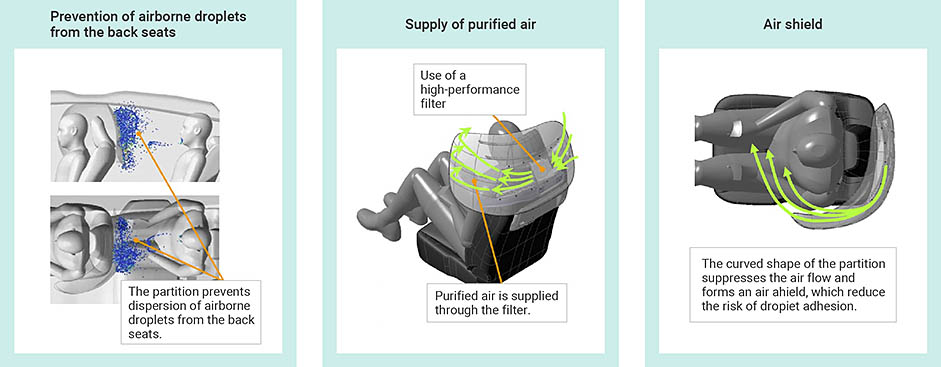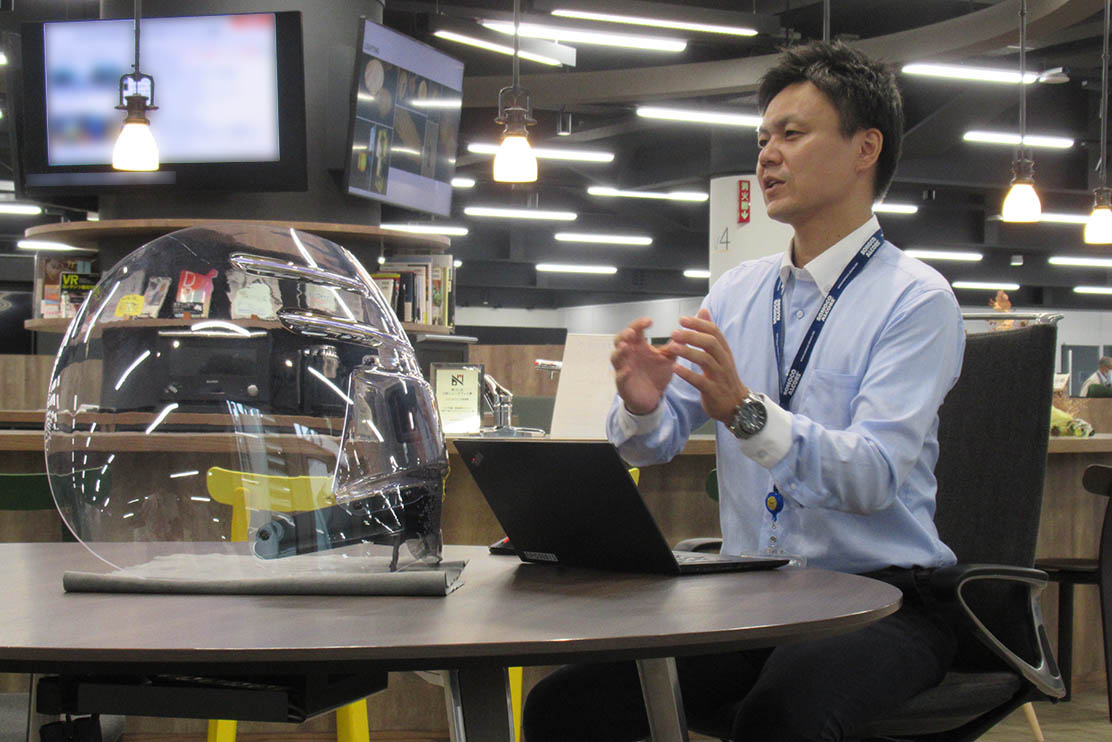Creating products that help people return to their daily lives more quickly
What is an anti droplet partition?
On September 13, we launched preliminary trial sales of a partition that can be retrofitted to the driver’s seat of taxis. As well as preventing the dispersion of droplets from the rear seats, a filter-equipped blower fan attached to the partition supplies clean air to the driver’s seat, while also forming an air shield to reduce the risk of droplet adhesion. In tests conducted by a third-party organization, the filter-equipped blower fan mounted on the partition achieved a removal rate of 99.9% or higher for viruses suspended in a 1m³ space.


Striving to make our customers even happier
While conducting demonstration tests, we listened to feedback from taxi drivers, had them actually try out the product in-vehicle, and continued making improvements to what we had developed. We made three improvements. The first was to improve visibility. In order not to hinder the receipt of payment from the customer or interfere with communication, we used transparent materials to make both the partition and the duct transparent. The second was to improve the sound. In response to a suggestion from a driver that the fan noise was bothersome, we reviewed the mounting structure of the fan to reduce the noise. The third was to improve operability. We enhanced operability by re-examining the mounting position and other factors so that the driver could operate the unit more easily.
The new anti droplet partition has three functions: 1) it reduces the risk of droplet dispersion from the rear seats, 2) it provides clean air (through a filter), and 3) it forms an air shield (controls airflow through the curved shape of the partition). As well as a 3D form that fits the shape of the seat, we have incorporated a design with functionality that makes the product more driver-friendly.

How did this product come about?
The spread of the coronavirus has transformed the world, including restricting people from going out and changing the way we work. In response to the pandemic, we began considering the development of products related to the hygienic environment of the automobile interior space, with the hope of contributing to the world by offering comfortable, safe, and environmentally sound products that would help people quickly return to their daily lives. Since the interior cabin space tends to promote the Three Cs that facilitate virus transmission, we considered how to develop items for a variety of mobility spaces and scenarios. From the six different proposals we considered for each development period (short, medium, and long term), we started with the short-term development item, partition for taxis.
Aiming to get our products into the world in a timely manner
In order to help people as much as possible, while not being beaten by the rapid spread of coronavirus, we set ourselves the goal of releasing a product within a year under the motto, “Timely release of a high-quality product.” Development began in May 2020, and in June we produced a simple mock-up. This was followed by demonstration tests in several vehicles in November, and then in around 50 vehicles in April 2021. We launched preliminary trial sales in September 2021. By applying our expertise in air conditioning and filters, we were able to develop this product in a short period of time.
During the development period, the pandemic made it difficult to have face-to-face meetings. Therefore, until development was fully underway, we moved forward with development by sharing information through online meetings twice a week, with the minimum number of people involved. Although it was challenging at times, we all worked with a high level of motivation to launch a high-quality product in the world, and as a result of our concerted efforts as a team, we were able to achieve the timely release of our product.


Created with a sense of “omotenashi” hospitality befitting of taxis
The design of the partition was undertaken by a designer from our Milan Design Branch, and is rather stylish, resembling “Edo kiriko,” a traditional type of Japanese cut glass. Some taxi customers are from overseas. The design was created with a sense of Japanese “omotenashi” hospitality and also creates a visual impression that relaxes customers. In the future, as an Interior Space Creator we will continue to “contribute to people’s quality of life, creating comfort, safety, and reassurance through innovation,” while striving to propose even higher-quality products in a timely manner.



 Media site to convey the Toyota Boshoku group vision for the future and initiatives
Media site to convey the Toyota Boshoku group vision for the future and initiatives



